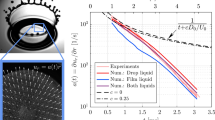Abstract
The formation of hydrophilic pores in a lipid bilayer during phase transition is described using the Smoluchowski equation with an additional term of the hydrophobic pore source. This term is added to account for defects in lipid packing during phase transition. We assume that the temporal sequence of the pores is a stochastic process, a non-stationary second-order Erlang flow. Flow characteristics depend on the equation solution and determine the formation times of the hydrophilic pores. The calculated distribution of the durations of intervals between hydrophilic pores is in a good agreement with experimental data published before. In the context of this model we describe the influence of poly(ethylene glycol) on the pore formation frequency.
Similar content being viewed by others
References
Heimburg T. 2010. Lipid ion channels. Biophys. Chem. 150, 2–22.
Wunderlich B., Leirer C., Idzko A.-L., Keyser U.F., Wixforth A., Myles V.M., Heimburg T., Schneider M.F. 2009. Phase state dependent current fluctuations in pure lipid membranes. Biophys. J. 96, 4592–4597.
Antonov V.F., Anosov A.A., Norik V.P., Smirnova E.Yu. 2005. Soft perforation of planar bilayer lipid membranes of dipalmitoylphosphatidylcholine at the temperature of the phase transition from the liquid crystalline to the gel state. Eur. Biophys. J. 34, 155–162.
Antonov V.F., Smirnova E.Yu., Anosov A.A., Norik V.P., Nemchenko, O.Yu. 2008. PEG blocking of single pores arising on phase transitions in unmodified lipid bilayers. Biofizika (Rus.). 53 (5), 802–809 [Translated version in: Biophysics. 53 (5), 390–395].
Andersen T., Kyrsting A., Bendix P.M. 2014. Local and transient permeation events are associated with local melting of giant liposomes. Soft Matter. 10, 4268–4274.
Saulis G. 1997. Pore disappearance in a cell after electroporation: Theoretical simulation and comparison with experiments. Biophys. J. 73, 1299–1309.
Gallaher J., Wodzinska K., Heimburg T., Bier M. 2010. Ion-channel-like behavior in lipid bilayer membranes at the melting transition. Phys. Rev. E. 81, 061925.
Anosov A.A., Kuprijanova M.S., Nemchenko, O.Yu., Norik V.P., Sergeenko, E.V., Smirnova E.Yu. 2015. States of lipid pores in bilayer lipid membranes at a phase transition in a LiCl solution with addition of molecules of polyethylene glycol. Biofizika (Rus.). 60 (1), 95–101 [Translated version in: Biophysics. 60 (1), 73–78].
Glaser R.W., Leikin S.L., Chernomordik L.V., Pastushenko V.F., Sokirko A.I. 1988. Reversible electrical breakdown of lipid bilayers: Formation and evolution of pores. Biochim. Biophys. Acta. 940, 275–287.
Smith K., Neu J., Krassowska W. 2003. Model of creation and evolution of stable electropores for DNA delivery. Biophys. J. 86, 2813–2826.
Powell K.T., Weaver J.C. 1986. Transient aqueous pores in bilayer membranes: A statistical theory. Bioelectrochem. Bioelectroenerg. 15, 211–227.
Stewart D.A., Gowrishankar T.R., Weaver J.C. 2004. Transport lattice approach to describing cell electroporation: Use of a local asymptotic model. IEEE Transactions on Plasma Sci. 32, 1696–1708.
Freeman S.A., Wang M.A., Weaver J.C. 1994. Theory of electroporation of planar bilayer membranes: Predictions of the aqueous area, change in capacitance, and pore-pore separation. Biophys. J. 67, 42–56.
Anosov A.A., Sharakshane A.A., Smirnova E.Yu., Nemchenko O.Yu. 2016. Usage of Smoluchowski equation with a source term for the model of the lipid pore formation at the phase transition. Biofizika (Rus.). 61, 1133–1138.
Nagle J.F., Tristram-Nagle S. 2000. Structure of lipid bilayers. Biochim. Biophys. Acta. 1469, 159–195.
Sillerud L.O., Barnett R.E. 1982. Lack of transbilayer coupling in phase transitions of phosphatidylcholine vesicles. Biochemistry. 21, 1756–1760.
John K., Schreiber S., Kubelt J., Herrmann A., Muller P. 2002. Transbilayer movement of phospholipids at the main phase transition of lipid membranes: Implications for rapid flip-flop in biological membranes. Biophys. J. 83, 3315–3323.
Sobol I.M. 1973. Chislennye metody Monte-Karlo (Numerical Monte Carlo methods). Moscow: Nauka.
Ventsel E.S., Ovcharov L.A. 2000. Teoria sluchainykh protsessov i ee inzhenernye prilozhenia (Theory of random processes and its engineering applications). Moscow: Vysshaja Shkola.
Lehtonen J.Y.A., Kinnunen P.K.J. 1994. Changes in the lipid dynamic of liposomal membranes induced by poly(ethylene glycol): Free volume alterations revealed by inter- and intramolecular excimer forming phospholipid analogs. Biophys. J. 66, 1981–1990
Mosgaard L.D., Jackson A.D., Heimburg T. 2013. Fluctuations of systems in finite heat reservoirs with applications to phase transitions in lipid membranes. J. Chem. Physics. 139, 125101.
Melikov K.C., Frolov V.A., Shcherbakov A., Samsonov A.V., Chizmadzhev Yu.A., Chernomordik L.V. 2001. Voltage-induced nonconductive pre-pores and metastable single pores in unmodified planar lipid bilayer. Biophys. J. 80, 1829–1836.
Author information
Authors and Affiliations
Corresponding author
Additional information
Original Russian Text © A.A. Anosov, A.A. Sharakshane, E.Yu. Smirnova, O.Yu. Nemchenko, 2016, published in Biologicheskie Membrany, 2016, Vol. 33, No. 6, pp. 387–397.
Rights and permissions
About this article
Cite this article
Anosov, A.A., Sharakshane, A.A., Smirnova, E.Y. et al. Bilayer permeability during phase transition as an Erlang flow of hydrophilic pores resulting from diffusion in the radius space. Biochem. Moscow Suppl. Ser. A 11, 8–16 (2017). https://doi.org/10.1134/S1990747816040139
Received:
Accepted:
Published:
Issue Date:
DOI: https://doi.org/10.1134/S1990747816040139




